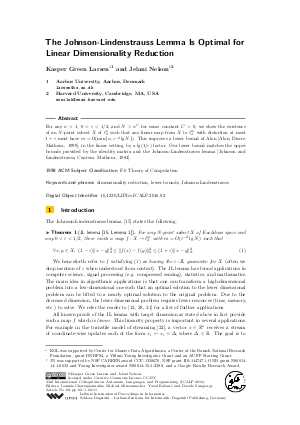The Johnson-Lindenstrauss Lemma Is Optimal for Linear Dimensionality Reduction
Authors Kasper Green Larsen, Jelani Nelson
-
Part of:
Volume:
43rd International Colloquium on Automata, Languages, and Programming (ICALP 2016)
Part of: Series: Leibniz International Proceedings in Informatics (LIPIcs)
Part of: Conference: International Colloquium on Automata, Languages, and Programming (ICALP) - License:
 Creative Commons Attribution 3.0 Unported license
Creative Commons Attribution 3.0 Unported license
- Publication Date: 2016-08-23
File

PDF
LIPIcs.ICALP.2016.82.pdf
- Filesize: 461 kB
- 11 pages
Document Identifiers
Subject Classification
Keywords
- dimensionality reduction
- lower bounds
- Johnson-Lindenstrauss
Metrics
- Access Statistics
-
Total Accesses (updated on a weekly basis)
0Document
0Metadata
Abstract
For any n > 1, 0 < epsilon < 1/2, and N > n^C for some constant C > 0, we show the existence of an N-point subset X of l_2^n such that any linear map from X to l_2^m with distortion at most 1 + epsilon must have m = Omega(min{n, epsilon^{-2}*lg(N)). This improves a lower bound of Alon [Alon, Discre. Mathem., 1999], in the linear setting, by a lg(1/epsilon) factor. Our lower bound matches the upper bounds provided by the identity matrix and the Johnson-Lindenstrauss lemma [Johnson and Lindenstrauss, Contem. Mathem., 1984].
Cite As Get BibTex
Kasper Green Larsen and Jelani Nelson. The Johnson-Lindenstrauss Lemma Is Optimal for Linear Dimensionality Reduction. In 43rd International Colloquium on Automata, Languages, and Programming (ICALP 2016). Leibniz International Proceedings in Informatics (LIPIcs), Volume 55, pp. 82:1-82:11, Schloss Dagstuhl – Leibniz-Zentrum für Informatik (2016)
https://doi.org/10.4230/LIPIcs.ICALP.2016.82
BibTex
@InProceedings{larsen_et_al:LIPIcs.ICALP.2016.82,
author = {Larsen, Kasper Green and Nelson, Jelani},
title = {{The Johnson-Lindenstrauss Lemma Is Optimal for Linear Dimensionality Reduction}},
booktitle = {43rd International Colloquium on Automata, Languages, and Programming (ICALP 2016)},
pages = {82:1--82:11},
series = {Leibniz International Proceedings in Informatics (LIPIcs)},
ISBN = {978-3-95977-013-2},
ISSN = {1868-8969},
year = {2016},
volume = {55},
editor = {Chatzigiannakis, Ioannis and Mitzenmacher, Michael and Rabani, Yuval and Sangiorgi, Davide},
publisher = {Schloss Dagstuhl -- Leibniz-Zentrum f{\"u}r Informatik},
address = {Dagstuhl, Germany},
URL = {https://drops.dagstuhl.de/entities/document/10.4230/LIPIcs.ICALP.2016.82},
URN = {urn:nbn:de:0030-drops-62032},
doi = {10.4230/LIPIcs.ICALP.2016.82},
annote = {Keywords: dimensionality reduction, lower bounds, Johnson-Lindenstrauss}
}
Author Details
References
-
Radosław Adamczak and Paweł Wolff. Concentration inequalities for non-Lipschitz functions with bounded derivatives of higher order. CoRR, abs/1304.1826, 2013.

-
Yuqing Ai, Wei Hu, Yi Li, and David P. Woodruff. New characterizations in turnstile streams with applications. In Proceedings of the 31st Annual Conference on Computational Complexity (CCC), 2016.

-
Noga Alon. Problems and results in extremal combinatorics-I. Discrete Mathematics, 273(1-3):31-53, 2003.

-
Noga Alon, Yossi Matias, and Mario Szegedy. The space complexity of approximating the frequency moments. J. Comput. Syst. Sci., 58(1):137-147, 1999.

-
Richard G. Baraniuk, Volkan Cevher, Marco F. Duarte, and Chinmay Hegde. Model-based compressive sensing. IEEE Trans. Inf. Theory, 56:1982-2001, 2010.

-
Emmanuel Candès and Terence Tao. Decoding by linear programming. IEEE Trans. Inf. Theory, 51(12):4203-4215, 2005.

-
Kenneth L. Clarkson and David P. Woodruff. Numerical linear algebra in the streaming model. In Proceedings of the 41st Annual ACM Symposium on Theory of Computing, (STOC), pages 205-214, 2009.

-
David Donoho. Compressed sensing. IEEE Trans. Inf. Theory, 52(4):1289-1306, 2006.

-
David L. Donoho and Carrie Grimes. Hessian eigenmaps: locally linear embedding techniques for high-dimensional data. PNAS, 100(10):5591-5596, 2003.

-
Lee-Ad Gottlieb and Robert Krauthgamer. A nonlinear approach to dimension reduction. In Proceedings of the 22nd Annual ACM-SIAM Symposium on Discrete Algorithms (SODA), pages 888-899, 2011.

-
David Lee Hanson and Farroll Tim Wright. A bound on tail probabilities for quadratic forms in independent random variables. Ann. Math. Statist., 42(3):1079-1083, 1971.

-
Piotr Indyk. Algorithmic applications of low-distortion geometric embeddings. In Proceedings of the 42nd Annual Symposium on Foundations of Computer Science (FOCS), pages 10-33, 2001.

-
T. S. Jayram and David P. Woodruff. Optimal bounds for Johnson-Lindenstrauss transforms and streaming problems with subconstant error. ACM Transactions on Algorithms, 9(3):26, 2013.

-
Jr. John W. Sammon. A nonlinear mapping for data structure analysis. IEEE Transactions on Computers, 18:401-409, 1969.

-
William B. Johnson and Joram Lindenstrauss. Extensions of Lipschitz mappings into a Hilbert space. Contemporary Mathematics, 26:189-206, 1984.

-
Daniel M. Kane, Raghu Meka, and Jelani Nelson. Almost optimal explicit Johnson-Lindenstrauss families. In Proceedings of the 15th International Workshop on Randomization and Computation (RANDOM), pages 628-639, 2011.

-
Daniel M. Kane, Jelani Nelson, and David P. Woodruff. On the exact space complexity of sketching and streaming small norms. In Proceedings of the 21st Annual ACM-SIAM Symposium on Discrete Algorithms (SODA), pages 1161-1178, 2010.

-
Daniel M. Kane, Jelani Nelson, and David P. Woodruff. An optimal algorithm for the distinct elements problem. In Proceedings of the Twenty-Ninth ACM SIGMOD-SIGACT-SIGART Symposium on Principles of Database Systems (PODS), pages 41-52, 2010.

-
Rafał Latała. Tail and moment estimates for some types of chaos. Studia Math., 135:39-53, 1999.

-
Yi Li, Huy L. Nguyen, and David P. Woodruff. Turnstile streaming algorithms might as well be linear sketches. In Proceedings of the 46th ACM Symposium on Theory of Computing (STOC), pages 174-183, 2014.

-
Jirí Matousek. On variants of the Johnson-Lindenstrauss lemma. Random Struct. Algorithms, 33(2):142-156, 2008.

-
S. Muthukrishnan. Data streams: Algorithms and applications. Foundations and Trends in Theoretical Computer Science, 1(2), 2005.

-
Jelani Nelson, Huy L. Nguŷẽn, and David P. Woodruff. On deterministic sketching and streaming for sparse recovery and norm estimation. Linear Algebra and its Applications, Special Issue on Sparse Approximate Solution of Linear Systems, 441:152-167, 2014.

-
Gilles Pisier. Probabilistic methods in the geometry of Banach spaces. Probability and Analysis, Lecture Notes in Math., 1206:167-241, 1986.

-
Gilles Pisier. The volume of convex bodies and Banach space geometry, volume 94 of Cambridge Tracts in Mathematics. Cambridge University Press, 1989.

-
Sam Roweis and Lawrence Saul. Nonlinear dimensionality reduction by locally linear embedding. Science, 290(5500):2323-2326, 2000.

-
Joshua B. Tenenbaum, Vin de Silva, and John C. Langford. A global geometric framework for nonlinear dimensionality reduction. Science, 290(5500):2319-2323, 2000.

-
Santosh Vempala. The random projection method, volume 65 of DIMACS Series in Discrete Mathematics and Theoretical Computer Science. American Mathematical Society, 2004.

